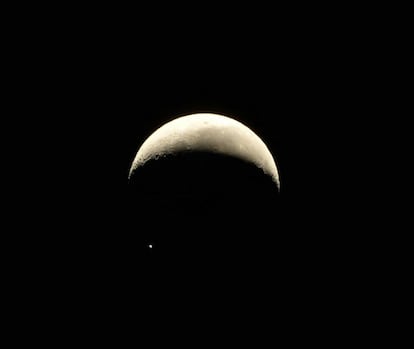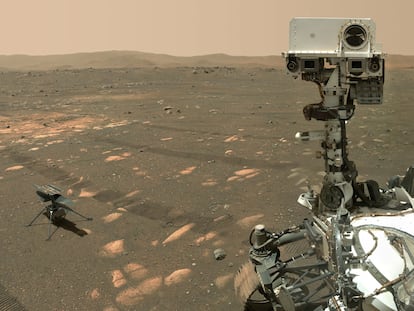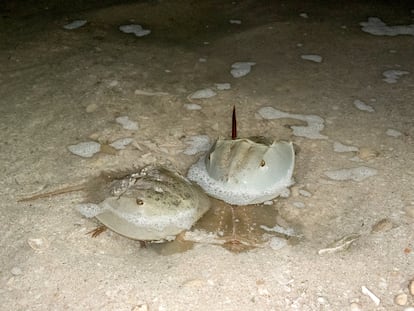How Jupiter and the Moon influence our lives
Next time we drink a glass of water, we should consider that our life may be more related to the stars than we think, and that in addition to stardust we are the result of a clash of giants

A compound’s isotopic properties can be used to study its origin and evolution, and we can apply this technique to the study of the origin of water on Earth. So what do we know about water on our planet? First of all, apart from Earth there is no other place in the Solar System or beyond that we know for sure has liquid water.
We know there is ice made of water on the Moon and on Europa and Enceladus (moons of Jupiter and Saturn, respectively), or on comets like 67P/Churyamov-Gerasimenko. We also know about the presence of water vapor in cryovolcanoes on these moons and in the interstellar medium, especially near areas where stars are forming. So is all this water the same – does it have the same isotopic composition?
As it happens, there is a paradox in the origin of water on Earth. The environment in which the Sun and the Earth were created was quite dry, despite the fact that water is one of the most abundant compounds in the star-forming zones where the Sun and Earth developed. Indeed, according to scientific modeling, rocky planets like Earth appeared in an area of the solar system near the Sun. Here, the high temperature prevented the formation of the kind of atmosphere where water could develop beyond a gaseous state. In such a way, the formation of water escaped the gravitational pull of the planet.
The presence of carbon, the other basis of life on Earth, also contains a paradox. Carbon is the fourth most abundant element in the universe after hydrogen, helium and oxygen and the second most highly occurring element in our bodies (almost 20% of our body mass is carbon). And yet, carbon is 10 times less abundant on Earth than in the universe at large.
Still, what is the relevance of carbon here?
Well, a small part (about 5%) of the meteorites that reach our planet today are high in carbon. They are called ‘carbonaceous chondrites’, and, interestingly, they contain high amounts of water as well. This means that they must have formed in areas far away from the Sun, beyond what is known as ‘the freezing line,’ where temperatures were already much lower which, in the early solar system, allowed the formation of water, methane or ammonia ice. This is one of the reasons why it is hypothesized that water arrived on Earth via a bombardment of these meteorites during a period when the Earth had already cooled considerably since its formation.
Indeed, another question is when water may have arrived. There is evidence for its existence on our planet 4.4 billion years ago, a little more than 100 million years after its formation, when the surface temperature of our planet must have been cold enough to freeze the water. This evidence is based on the study of certain minerals such as zircon, which resists geological changes and atmospheric action quite well, thus giving us information about the origins while not so much about the evolution of water on Earth.
The study of the ‘isotopic abundances’ of water present in carbonaceous chondrites, at least in those as old as the Solar System itself, yields results very similar to those of Earth’s water. In particular, the amount of deuterium versus protium is usually studied, as the ratio of these isotopes for Earth’s water is quite similar for chondrites in the vicinity of Jupiter, some of them taken from the asteroid Vesta. Further out (for example, in comets from the outer reaches of the Solar System), the abundances of deuterium are much higher, occurring in what is known as the Oort cloud.
So what do Jupiter and the Moon have to do with the whole story of water on Earth? In the case of Jupiter, its influence in the matter comes from its intense gravitational action in the Solar System, which agitates the orbits of a multitude of asteroids. Some evolutionary models suggest that, at some point in the history of the Solar System, Jupiter may not have had the same orbit it has today – instead, it may have been closer to the Sun before migrating towards its current position. This excursion of Jupiter would have caused it to sweep up objects along the way, which in turn could have been launched en masse into inner orbits closer to the Sun, thus reaching Earth. This is what is known as ‘late massive bombardment’ – evidenced, for example, by the concentration of meteorite impacts on the Moon around 3.9 billion years ago.
This is where the role of the Moon appears. To understand this, we must return to the study of isotopes, but this time we are talking about molybdenum, a much rarer element. Molybdenum is a metal that has 42 protons (for comparison, iron has 26), and dozens of isotopes. It turns out that the relative abundances of these isotopes on Earth occur in the middle of the abundances observed for carbonaceous chondrites and chondrites from the far reaches of the Solar System.
Taking into account that molybdenum is denser than iron (a small one-centimeter cube of the metal weighs 10 grams, compared to seven grams if it were iron and one gram if it were water), and that most of the iron on our planet is in its core, it would not be strange to think that the molybdenum that reached the Earth at the beginning of its history sank to the Earth’s core. Surface molybdenum, in the crust or upper mantle, could have a more recent origin, and its isotopic composition points to areas where there was plenty of carbon and water. The timing works to associate this arrival of molybdenum and water with the impact of Theia, the protoplanet that caused the formation of the Moon after colliding with the Earth 4.5 billion years ago, mixing much of its material with the Earth’s mantle. According to these ‘molybdenic studies,’ Theia would be a planet coming not from the zone of rocky planets, but from the zone of gaseous planets (Jupiter, Saturn) and/or icy planets (Uranus, Neptune), which are full of water.
So, while the evidence is not conclusive, it could well be that the planetary cataclysm caused by Theia, with the consequent formation of the Moon, perhaps with the mediation of Jupiter, had a fundamental effect on the appearance of life for several reasons, including accounting for most of the water existing today on our planet.
As such, when we get thirsty, let us consider that our life may be more related to the stars than we think, and that in addition to stardust we are the result of a clash of giants.
Tu suscripción se está usando en otro dispositivo
¿Quieres añadir otro usuario a tu suscripción?
Si continúas leyendo en este dispositivo, no se podrá leer en el otro.
FlechaTu suscripción se está usando en otro dispositivo y solo puedes acceder a EL PAÍS desde un dispositivo a la vez.
Si quieres compartir tu cuenta, cambia tu suscripción a la modalidad Premium, así podrás añadir otro usuario. Cada uno accederá con su propia cuenta de email, lo que os permitirá personalizar vuestra experiencia en EL PAÍS.
¿Tienes una suscripción de empresa? Accede aquí para contratar más cuentas.
En el caso de no saber quién está usando tu cuenta, te recomendamos cambiar tu contraseña aquí.
Si decides continuar compartiendo tu cuenta, este mensaje se mostrará en tu dispositivo y en el de la otra persona que está usando tu cuenta de forma indefinida, afectando a tu experiencia de lectura. Puedes consultar aquí los términos y condiciones de la suscripción digital.
More information
Últimas noticias
Most viewed
- Sinaloa Cartel war is taking its toll on Los Chapitos
- Oona Chaplin: ‘I told James Cameron that I was living in a treehouse and starting a permaculture project with a friend’
- Reinhard Genzel, Nobel laureate in physics: ‘One-minute videos will never give you the truth’
- Why the price of coffee has skyrocketed: from Brazilian plantations to specialty coffee houses
- Silver prices are going crazy: This is what’s fueling the rally











































